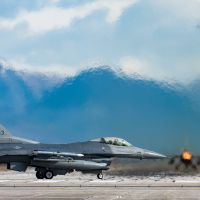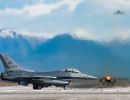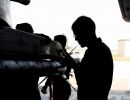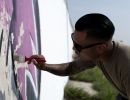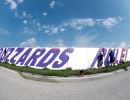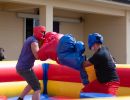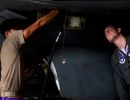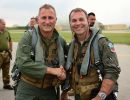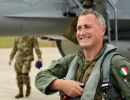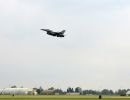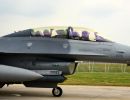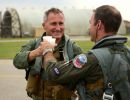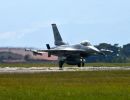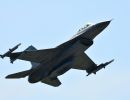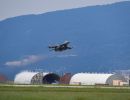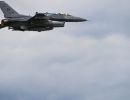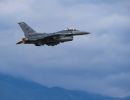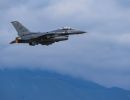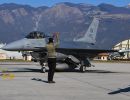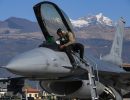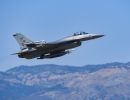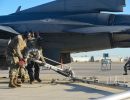The 510th Buzzards and the 31st Aircraft Maintenance Squadron, or AMXS, from Aviano, replaced the 34th FS Rams and 388th AMXS from Hill AFB, Utah. The 34th was preceded by the 79th FS Tigers and 20th AMXS from Shaw AFB, South Carolina. The 79th replaced the first US F-16 unit to operate from Afghanistan—the 421st FS Black Widows, also from Hill AFB. Both deployments from Hill included Air Force Reserve Command personnel from the 419th Fighter Wing as well as support personnel from the 388th FW. Both of those wings are based at Hill.
Code One was invited by the 510th Expeditionary Fighter Squadron Commander, Lt. Col. Greg Sarakatsannis, to submit questions to the unit personnel about their time in Afghanistan. The responses came from SMSgt. Brian Alexander, the production superintendent; Capt. Jason Curtis, an F-16 instructor pilot; MSgt. Erik Gatson, the weapons superintendent; and Capt. Joshua Kubacz, the weapons and tactics officer.
How did you prepare for the deployment?
Alexander: We start preparing for these deployments the day we return from the previous one. We stay on top of our training for our operations and our maintainers. For Afghanistan, we knocked out some of the more extensive inspections and time change items on the aircraft to ensure they would not come due during the deployment. That advance work prevented aircraft downtime. The maintenance personnel put in months of preparation and lots of hard work to make the deployment successful.
Gatson: We deployed stateside to Nellis [AFB, Nevada] and Eglin [AFB, Florida] where we conducted training operations, loading live and inert munitions that would mirror what we would see in theater. We had our load crews increase their weapons loads during their monthly load barn training sessions. We conducted extensive operational checks on the weapons system to ensure that it was fully mission capable.
Kubacz: We had a very aggressive AEF spinup because our squadron spent the last few years training for NATO missions without access to a local range. During our preparation in the US, we dropped a significant number of precision guided munitions and did a lot of 20mm gun strafing.
How much of an impact are F-16 operations having in Afghanistan?
Alexander: F-16 operations are having a huge impact here. We support the ISAF [International Security Assistance Force] on the ground and assist when needed. We are often scheduled to provide air cover—and can be called on to do so at a moment’s notice.
Curtis: The role of the F-16 is pivotal to the success in stabilizing Afghanistan. We bring an asymmetric balance in favor of ISAF to the conflict.
What is the most difficult aspect of operating out of Bagram AB?
Curtis: I can’t pin down one single aspect, but the cumulative effect of multiple tests all at once on a compressed timeline is very challenging. We may not know our target before we take off or even minutes before we employ our weapons. We have to communicate effectively with someone on the ground who is being targeted. We have to build a mental picture of the ground situation within minutes of arriving on the scene. We may have to drop weapons on an enemy position that is within meters of friendly forces—all while leading a formation, directing the flight, and dodging thunderstorms or mountains at night. All of these factors call upon our highest level of skills and judgments.
What other aircraft are operating at Bagram?
Alexander: Numerous aircraft and vehicles operate from this base. Just in our operations group alone we have F-16s, F-15Es, HH-60s, MC-12, and C-130s. [Editor’s note: The MC-12 is a military version of the Hawker Beechcraft Super King Air 350. The aircraft is equipped with an electro-optical infrared sensor and other sensors.]
Curtis: We are in a multinational coalition consisting of multiple NATO countries and other coalition partners including South Korea. We have tankers airborne around the clock. Cargo aircraft, including C-5s, C-17s, and C-130s, also support our operations.
How are the flying and working conditions in Afghanistan?
Curtis: Flying in theater is very challenging. We have to deal with other aerial assets, mountainous terrain, and thunderstorms while carrying a full combat load of bombs, missiles, bullets, sensors, and countermeasures. Flying at night presents unique challenges with trying to support the troops on the ground. We really have to know the terrain and know how to effectively deal with tactical considerations involving sensor coverage of troop formations, forward operating bases, combat outposts, and convoys. Then we have to formulate a solution to negate the threats these various friendly forces may encounter.
Gatson: We arrived in the summer months and experienced some extreme temperatures. The heat forced us to monitor the crews more closely for fatigue. We rotated personnel on a work-rest cycle as much as possible so no one was exposed to the elements longer than required. The weather is extreme here, and ground crews have to be very thorough when loading weapons and when performing flight inspections.
Kubacz: Hot, windy, and dusty. The blowing dust can make sensor coverage and weapon guidance a significant challenge.
Describe your operations tempo at Bagram.
Alexander: We fly every day. Pilots using night vision capabilities fly every night as well. I can say we rarely have all the jets on the ground.
Curtis: We cover the entire country. We may get re-rolled into a troops-in-contact situation at the last second. This change forces us to be extremely flexible and agile in the air. We never know what to expect from a typical combat sortie.
All but two of my combat sorties have been at night. I have relied upon my training experience and instinct to be successful on any given night. Fortunately, we have leading edge technology with state-of-the art systems in the F-16. The combination of night vision goggles, Link-16, and the Sniper Advanced Targeting Pod gives us a high amount of situational awareness at night.
We have a live range where we can conduct attack training to maintain our employment proficiency. A majority of our attacks require us to be extremely precise with attack parameters. We continually try to improve upon our execution by training to high stress scenarios while evaluating our adherence to strict attack parameters.
Kubacz: We often get the opportunity to practice nine-lines to help aircrew and ground parties maintain proficiency in close air support procedures, that practice depending on how busy things are on the ground after completing our assigned tasking. [Editor’s note: “Nine-lines” refers to nine lines of information soldiers on the ground used to direct airstrikes.]
What new F-16 capabilities are you using in theater?
Curtis: The most recent advancement in technology is the GBU-54 [500 pound] laser or satellite guided JDAM. This weapon offers the best of both worlds by having an inertial aided tail kit that receives GPS guidance and a nosecone-mounted laser sensor that gets laser updates from a laser designator. This capability presents a way to deal with a variety of tactical situations, including the ability to target moving vehicles.
Kubacz: Our squadron employed the first successful GBU-54 in Afghanistan. Since then, we have had several subsequent successes against slow and fast moving targets.
Is the F-16 well suited for your missions?
Curtis: Absolutely. The F-16 has been able to effectively adapt to multiple missions with close air support being just one example. The F-16 really shows its worth with the integration of new systems as they come online. The result we see today is testament to American ingenuity and willpower to make sure that we can provide support to our ground forces and return home safely from a hostile environment after successfully completing the mission.
What do you miss the most about home?
Alexander: I missed my daughter’s high school graduation. She is now out of the house and off to college. Overall, I miss my family and home-cooked meals.
Curtis: The thing I miss the most about Italy is my beautiful wife. She is amazing. I can’t wait to get back to her. I also miss my family back in the US and the mountains of Montana where there is peace and the air is pure.
Kubacz: I miss my family, of course. My wife gave birth to our first child two months into the deployment. I can’t wait to meet my baby girl and to be a part of her life. I also look forward to relieving my wife of some of the burdens caused by my absence.
What about your missions in Afghanistan brings pilots the most satisfaction?
Alexander: Saving the lives of our ground troops by responding to troops-in-contact calls.
Curtis: My motivation is to protect the eighteen-year-old soldier at a remote outpost who is getting shot at every day. Hearing “thanks for being here” on the radio means everything to me.
Kubacz: Knowing my aircraft helped keep people on the ground safe and providing security to the people of Afghanistan.
{joomplucat:127 limit=100|columns=4}


